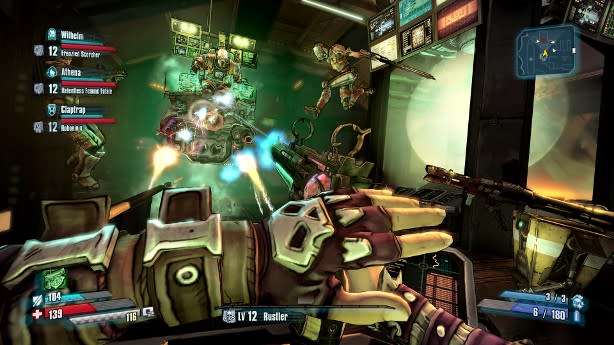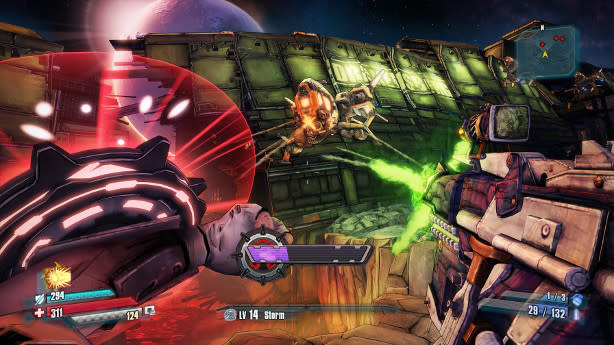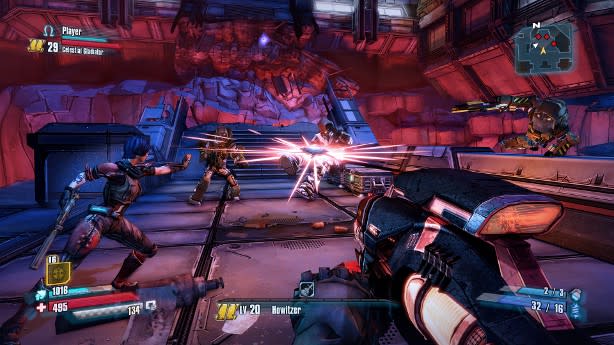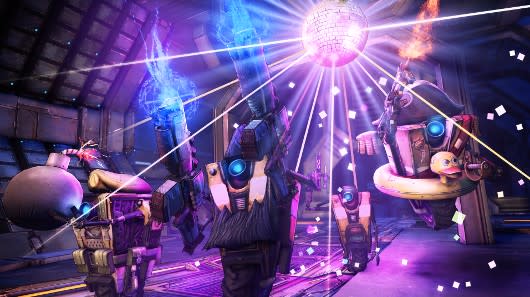Borderlands: The Pre-Sequel review: You don't know Jack
Xbox 360, PS3, PC
Borderlands: The Pre-Sequel is all about loot, murder, humor, loot, swarms of enemies and loot. It looks like a comic book, plays like a shooter, and feels like that one hilarious idea you and your buddies had at two in the morning after a night of riding around town and chugging energy drinks. Also, loot. In other words, it's more Borderlands.
The Pre-Sequel introduces a few new ideas into the franchise – including near-zero gravity, oxygen management and shiny character classes based on NPCs from the previous games. Players participate in the story of Handsome Jack, before he became the villain in Borderlands 2, back when he was just a funny dude with wild ideas about being a hero.
Still, while The Pre-Sequel boasts the loot of a full Borderlands game, it's missing a touch of depth and a dash of polish.
Somehow, it feels as if there's even more loot in The Pre-Sequel than in Borderlands 2, which was marketed as the game with 87 bazillion guns. Basically every object in the game is marked with a little green light, potentially containing money, ammo, weapons, shields or class accessories. The sheer amount of little green lights is almost sinister, each unopened box taunting collectors with ammo they can't carry and guns they don't want. There are, of course, a handful of new guns to excite veteran Borderlands players, including rifles that shoot lasers in a constant, deadly stream – but these are fairly rare. It took about four hours for me to stop stressing over the unopened chests and lockers scattered around Elpis, Pandora's moon and the main battleground of The Pre-Sequel.
Elpis brings with it some new mechanics, including the need for artificial oxygen and high-flying jumps. Early in the game, characters (except for the robot Claptrap the Fragtrap) get an oxygen kit that contains a set, rechargable amount of air. There are bubbles and pits of oxygen on Elpis, but most of the moon is uncovered, draining your supply as you run around. Enemies graciously drop air canisters as they're killed, and some of those damn green-light boxes contain oxygen too. Air management is a subtle yet effective mechanic, as it adds a layer of strategy to battles and exploration. Say you need to head toward a certain base, but your oxygen is low and the mini-map shows a pocket of air close by, in the opposite direction and potentially surrounded by enemies – what do you do?
Jumping on the moon is a floaty, extended affair, and players are able to double-jump for an extra push in the direction they're flying, though that drains oxygen quickly. Jumping is also a weapon: Fly up and slam down to injure and knock back nearby baddies. The jumps feel slow and awkward at first, but they do become natural and handy. However, against families of beastly kragons – where this jump-and-slam technique should be most effective – the leaps retain that slow, clunky vibe, with my character often getting caught on the beasts, or rising into the air and then landing on the back of a kragon without harming it at all.
Most of the time, though, the jet-pack jumping mechanic is a useful, lively touch, especially nifty when making the leap between two grey islands jutting out of a field of lava. The environments of Elpis are extreme in this sense, bright reds and orange for the lava flows, shining blue for the oxygen and quick-freeze nitrogen fields, neon purple for the laser that shoots into Elpis at regular intervals, shaking the moon as it destroys sections at a time. Elpis is one of Borderlands' most beautiful scenes yet.
There's something just slightly off about parts of The Pre-Sequel, though, and it may be tied to the double-jump. The level design is oddly confusing in some areas, to the point where I have to stop and ask myself if the game is being dense, or if I am. My instinct is to take the shortest path to waypoints on the mini-map, meaning sometimes I try to scale a rock face or industrial complex – to varying results. Trial and error isn't a terrible thing, but when I'm fighting off bullets and bombs from a swarm of scavengers, I want to know, not guess, where my exit points are. It seems that some of these areas are designed to be accessed via awkward, floaty parkour, while others look like they should be, but clearly, painfully, they aren't.

For example, one early mission in the hub city of Concordia has players access a number of communication towers. I found the first just fine, but another took a frustrating amount of time and endless backtracking while I searched for a staircase or lift to let me reach the roof, as an NPC told me to do. Eventually, I tried jumping around the buildings below the waypoint, and I found a position on top of a narrow sign that allowed me to jump to the roof. It felt like the wrong solution. It still does, mainly because that type of movement isn't repeated throughout the game; you're not able to jump on top of every slim outcropping, only some.
Some of the fights, too, are off in an strange way. The first battle against the high-flying, heavily armored Deadlift is achingly difficult, even with a co-op partner. It plays like a mid-game fight stuck at the very beginning of the story, introducing green launch pads that fling your character across the map or straight up. It's a hard lesson in how to jump well, and not necessarily a good one. Later on, smaller battles against hordes of outlaws, scavs, raiders and kragons get ridiculously busy, to the point where you can't turn around before you're hit with 50 bullets and scaly tails. During one of these fights, I got trapped against a wall, enemies pinning me in place so that I couldn't move at all.
To be succinct: You'll probably die a lot in The Pre-Sequel, and some of those deaths may be extra frustrating thanks to circumstances beyond your control.

Recent Reviews
The new character classes fit well within the Borderlands lore, and not just because they're already a part of it. Their strengths are well-defined: Nisha the Lawbringer is a great choice for those going solo, since her special skill is to enter a rapid-fire, extra-damage, auto-aim mode at will. It's good for taking out, or at least seriously damaging, several enemies at once. She's become my go-to character. Athena, meanwhile, is Captain America with a sword, and she's great as an assassin, while Claptrap is the support character and Wilhelm is the tank. Athena may be the most fun – she has a shield that not only absorbs damage, but can also be flung to explode all over an enemy, before it flies back into her grasp. In terms of personality, she's on the bland side, while Claptrap, the most boisterous character, appears to be the weakest fighter. Wilhelm can deploy a pair of attack drones, making him good for players who generally rush into a battle without thinking about the damage they may end up taking.
The Pre-Sequel's missions don't offer much variety, and at times they feel artificially extended in a specific pattern. The missions tend to blend together, but they are carried by a cast of interesting, mostly comedic bosses and allies along the way, including characters we can connect to from past games. Jack, for his part, is hilarious, coming off as a mash-up of Jason Statham in Crank and Cookie Masterson, the host of You Don't Know Jack.
Still, the missions are generally predictable. One has players seek out an enemy on one of Elpis' fortified islands. To get there, you have to fight through a few rooms of foes and cross a bridge, but once you reach the bridge, it's made un-crossable. So, you have to pump methane into the lake of lava below – you find the methane pump and switch it on, but it's empty. You're then sent to fill the methane reserves so the pump works, but something at the pump station goes wrong again. This all involves a fair bit of travel and a handful of hefty fights, plus moments of "find this button" and "flip this switch" in between. Finally, you pump the methane, the lava becomes walkable, and you have to fight off some kragons to get across.
Essentially, the missions break down as such:
Do This Thing.
This Thing is broken, so do This Other Thing first.
This Other Thing is also broken, so fix Another Thing first.
Fix Another Thing.
Fix and do This Other Thing.
Fix and do This Thing.
Repeat.

The narrative's repetitive nature isn't awful – let's be honest here, we're playing Borderlands for one thing, and it isn't the story. It's to shoot a bunch of weird, wacky enemies in the face and to shovel as much loot into our packs as we can carry. The Pre-Sequel succeeds in this goal, offering players plenty of enemies to shoot (at times too many) and a few new weapons with which to incinerate them. This isn't Borderlands 2, but Gearbox and 2K Australia are right to shy away from naming it as the third in a series – when the missions begin to drag on and the loot becomes overwhelming, The Pre-Sequel could be an over-eager, try-hard installment of DLC for Borderlands 2. Overall, though, it is its own game, made so by the familiar yet fresh characters, and new environments, weapons and enemies.
Borderlands: The Pre-Sequel has the makings of a pretty great Borderlands game. There are plenty of enemies begging to have their faces shot. The environments on Elpis are stunning neon spectacles, there are plenty of new guns that are bundles of violent joy to use (including lasers!), and the new characters are well-rounded. The Pre-Sequel is missing just a bit of soul, but it has plenty of heart – hearts exploded by laser rifles.

This review is based on an approved Steam download of the PC version of Borderlands: The Pre-Sequel, provided by 2K Games. Images: 2K Games.
Joystiq's review scores are based on a scale of whether the game in question is worth your time -- a five-star being a definitive "yes," and a one-star being a definitive "no." Read here for more information on our ratings guidelines.


